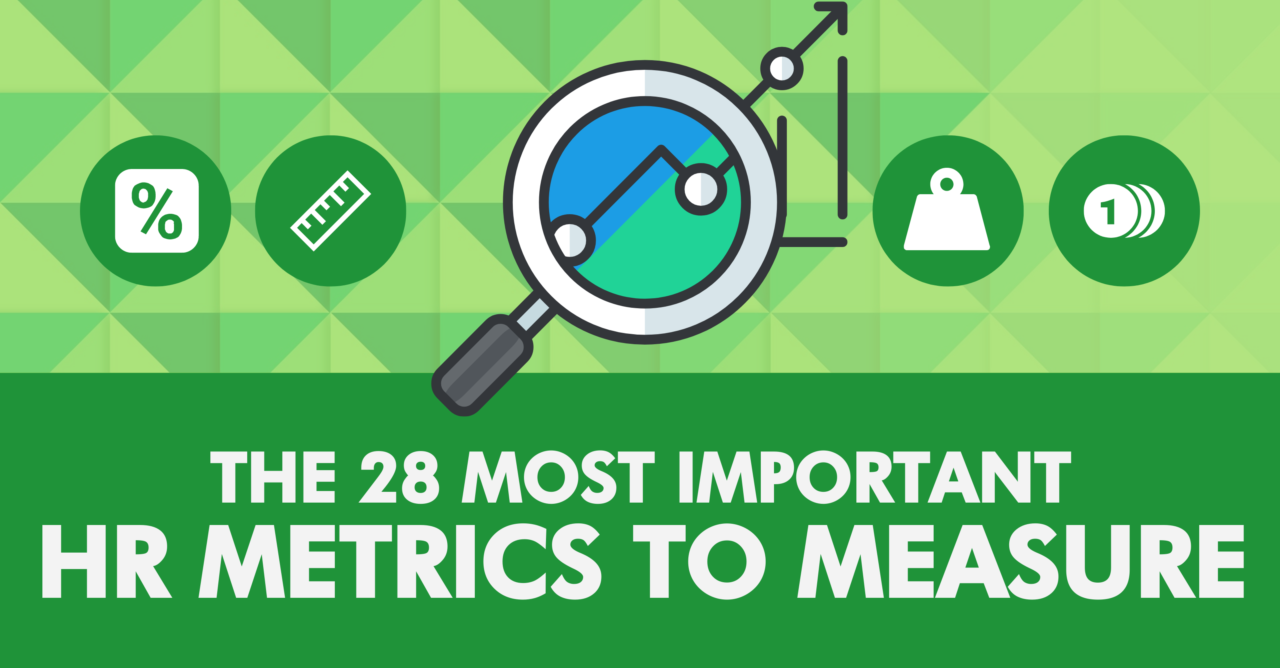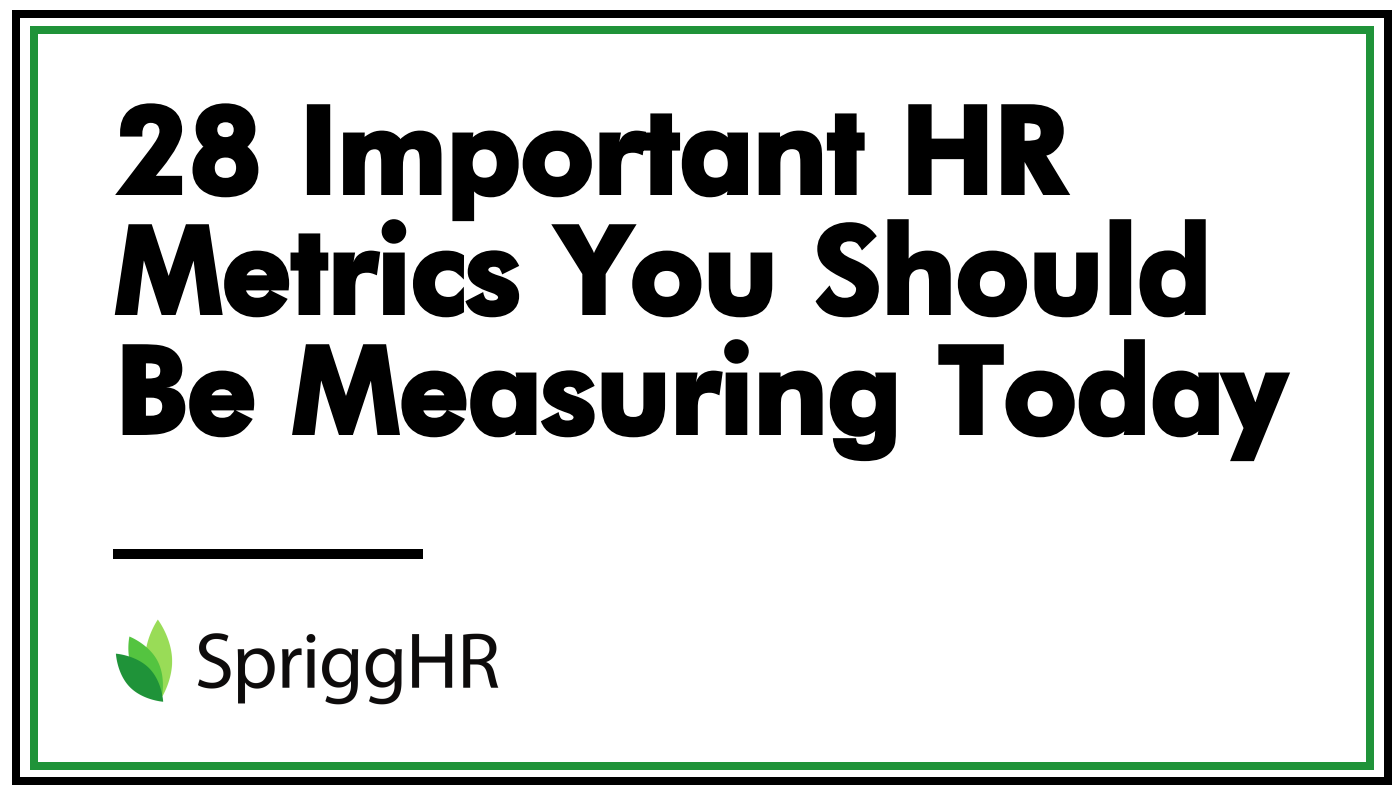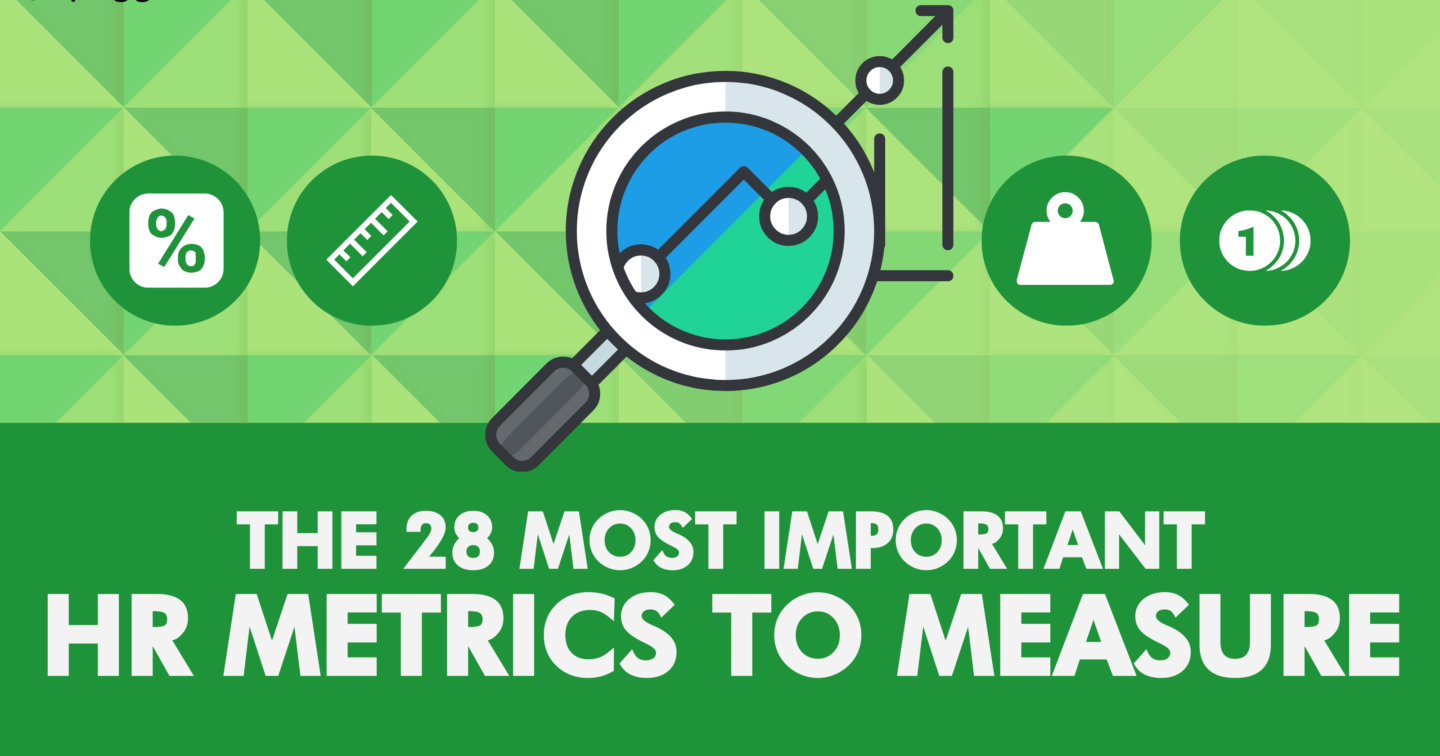
28 Important HR Metrics to Measure
Strategic HR is a practice that is ever-growing in popularity among businesses around the world. Perhaps one of the biggest indicators of that growing popularity is the increased focus on the use of HR metrics as a key component of an organization’s overall business strategy.
But, what are HR metrics? And if executives are beginning to value them much more, how can a company go about improving their data analysis game to meet those increasing expectations? If you want to make a real impact on your organization, you need to have a thorough understanding of the basics of HR metrics, and which ones in particular you should begin measuring today.
In a hurry? Take our HR Metrics white paper to go!

HR Metrics
Send download link to:
What Are HR Metrics?
Human Resource metrics are the measurements that help organizations track key areas in their HR data. More specifically, they are the metrics that track an organizations human capital, and measure how effective their Human Resources initiatives are on the overall success of the business. HR metrics can be broken down into three areas, each with their own set of key HR metrics associated with those areas:
1. Organizational Performance
- Turnover percentages
- Percentage of regretted loss
- Statistics on reasons for personnel leaving
- Absence percentages, and absence behaviors
- Recruitment statistics (e.g. time to fill, number of applicants, recruitment costs)
2. HR Operations
- HR efficiency (e.g. time to resolve HR self-service tickets)
- HR effectiveness (e.g. perception of service quality)
3. Process Optimization
- Changes in HR efficiency and effectiveness over time, which are used to re-engineer and reinvent the nature of HR in the organization, optimizing its delivery process for the future.
These specific examples will be fleshed out in further detail later but recognizing the three overarching areas of HR metrics is critical if you hope to keep your tracking system organized and efficient.
The Importance of Keeping Track of HR Metrics
Measuring the types of information and data listed above helps organizations figure out their people strategy for the future, recognizing what is working well for the organization, what needs improvement, and what trends they can expect down the line. Both executives and HR professionals agree that measuring HR areas and monitoring its impact on an organization is critical. As a result, HR metrics are transforming from a business advantage to a must for any HR team that seeks to build up a solid, data-driven business strategy for their company.
The 28 Most Important HR Metrics You Should Be Measuring
The amount of data that can be tracked and measured in HR is astounding, but in order to gain the most from the HR metrics you gather, you first need to identify the key figures that will provide the clearest insight into how your company can grow and succeed down the line.
HR Metrics in Recruitment
1. Headcount: the total number of employees in the organization, or within the department you are tracking.
2. Demographics: the characteristics of the workforce, including age, gender, education level, and length of service in the company.
3. Time to Hire: the average number of days between when a job is posted, and when the candidate accepts the offer.
4. Acceptance Rate: the number of offer letters extended by the organization, divided by the number of candidates who accept an offer.
5. Cost per Hire: the average cost of hiring a new employee. This can be generated by calculating the sum of both internal and external hiring costs, then dividing that value by the total number of employees hired in a given period.
6. Time to Productivity: the time it takes for new hires to become acclimated in the organization and start working at full productivity.
7. New-Hire Turnover: the number of new hires who leave the organization within a set period of time (e.g. within their first year of employment).
HR Metrics in Engagement and Retention
8. Employee Satisfaction: the number of employees who would recommend the organization as a good place to work, versus the number of employees who wouldn’t.
9. Total Turnover Rate: the number of employees who leave the company within a given period of time, divided by the average number of total employees. This is usually indicated in a percentage value, so this decimal is then multiplied by 100.
10. Voluntary Turnover Rate: the turnover rate including only the employees who voluntarily leave the organization.
11. Talent Turnover Rate: the turnover rate among the organization’s highest-performing and highest-potential employees.
12. Retention Rate: the opposite of a turnover rate, in that the number of employees who remained in the organization over a given period is divided by the total number of employees.
13. Retention Rate per Manager: the retention rate broken down by individual teams and managers.
HR Metrics in Time Tracking
14. Absence Rate: the average number of days employees are absent in a given period of time, not including approved PTO
15. Absence Rate per Manager: the absence rate broken down by individual teams and managers.
16. Overtime Hours: the number of overtime hours worked by employees in a given period of time. This can be calculated either as an average number, broken down by individual employees.
HR Metrics in Employee Value & Performance
17. Performance & Potential: a nine-box performance matrix where employees are categorized according to their performance and potential levels
18. Employee Performance: metrics as received through self-assessments, peer reviews, manager assessments, or a combination of all three.
19. Goal Tracking: usually done so through a performance management software that include goal tracking, this metric monitors the goals employees have set, how they connect to larger organizational goals, the progress the employees have made on those goals.
20. Company Performance: a comparison of how well employees are performing, versus how engaged and valued they feel within the organization.
21. Revenue per Employee: the total amount of revenue generated in a given period of time, divided by the total number of employees.
HR Metrics in Training and Development
22. Training Expenses per Employee: the total cost of the organization’s training courses and programs, divided by the total number of employees.
23. Training Completion Rate: the number of employees who complete a given training course/program, divided by the total number of employees. This value is then multiplied by 100 to get a percentage.
24. Time to Completion: the amount of time it takes for an employee to complete a given training course or program.
25. Training Effectiveness: this can be measured in several different ways, including running tests or assessments that generate a pass/fail rate for training programs.
HR Metrics in HR Service & Software
26. Ratio of HR Professionals to Employees: the number of employees in the organization per HR professional on the HR team.
27. Cost of HR per Employee: the total amount the organization spends on HR functions and services, divided by the total number of employees in the organization.
28. HR Software Employee Participation Rate: the number of employees who actively use the organization’s HR software, divided by the total number of employees in the organization.
Begin Measuring HR Metrics Today
The work to manage and measure the above-mentioned metrics in the Human Resources department is vital to any organization’s long-term success. However, when you aren’t measuring and tracking the key HR metrics that matter most, it becomes very difficult to pinpoint just how well your managerial efforts are working, or how you can best improve them for sustainable success. If your organization is not measuring any HR metrics right now, be sure to sit down with your executive and HR teams and identify the areas of data you need to start tracking. Especially for companies just starting out in the HR metrics practice, keeping it simple is key. There is no need to dive into hundreds of different reports right away. If your company is already measuring some HR metrics, ensure that all the data being collected is beneficial to your organization and is helping you to reach your company goals.
Software tools such as SpriggHR can help streamline your HR metric tracking and measuring process, pinpointing the areas your company is succeeding in, and highlighting others that may need some improvement.
Take our HR Metrics white paper to go!
HR Metrics
Send download link to:




